|
|
Roman sights in the Provincia
by: Q. Claudius Locatus
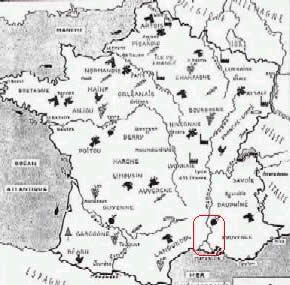
I have already visited a lot of Roman architecture. I want you to take part in it! Here is a part of my experiences.
The city of Rome was known for its great and impressing buildings. Many tourists go and visit it. But is this really thé place to be for Roman architecture?
It is true that Rome was the city of cities, the almighty of the Roman civilisation. But today? I haven't visited Rome yet, Atticus did - maybe can he justify or deny what I'm writing here - but my impressions of the modern day Rome are telling me many of the remnants are overbuild and cannot be laid bare, or are in a bad state. Also many are affected by the modern day diseases: acid rain, exhaust fumes, etc...

So I asked myself the question: where can I see remnants of a glorious Roman Empire without being in a big city, without many affections? I came to the answer: Provincia Romana. In the south of France there are many remnants of the Roman empire that aren't (yet) affected by the diseases of the big city.
I would like to tell you all something of a wonderful journey among Roman culture. I mostly visited Theatres and Amphitheatres.
The most beautiful of them all is the theatre of Orange, a little city near Avignon in the Rhône valley. The ancient city of Arausio was a colony that was founded by Julius Caesar for veterans of the second legion that was commanded by the father of Tiberius.
The founding of the Colony was celebrated by putting up a triumphal arch, which can still be sighted today. The triumphal arch exists out of three arches; two small ones at the sides and one bigger in the centre. It's a rather impressing building; not only by its seize (19,5m in breath, 19m in height) but also by its beautiful decoration. The decoration shows scenes of the victory from Ceasar on Massilia (Marseille). Some of the Relief has disappeared from the erosion caused by the Mistral, one of the famous winds in the south France, who sometimes carries sand of the Sahara with it.
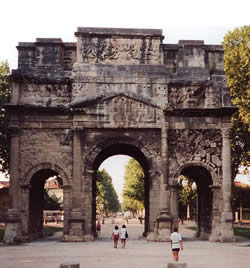
But, as I stated before, the most impressive monument in Arausio is the completely intact theatre. The most special about it is the almost perfect state of the scaena (with a length of 103m and a height of 37m) the back wall after the stage, that already has disappeared in many other Theatres. On the scaena one still can see the hooks and the posts who had to support the velarium. The interior is richly decorated and in the middle of the scaena a statue is placed of Augustus (the only statue that is left of him), who gave the order to build the theatre. The "seats" (stone stairs on which the people sat) are still intact and a cool relief when you're sitting on it in the burning sun. The acoustics of the theatre still are remarkable. You can hear a match set on fire on the stage while sitting on the highest seats. The theatre is partly build on a natural slope, partly on an artificial slope. I have seen many theatres (Lyon, Vaison la Romaine, Carthago in Tunisia, Epidauros in Greece, ...) but Arausio is still the best I ever saw.
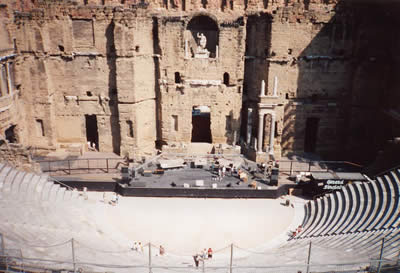
Not far from the theatre there are some temples of a large temple and a building with an exedra. They suspect that this is one of the only gymnasiums left in Gallia. There is not much left but the foundations. Just next to the theatre the foundations of public baths were discovered. It seems there was a whole complex of public activities around the theatre.
Nîmes, a city in the south of France, only 50km away of the beautiful but smaller city of Orange, was founded by soldiers of Antonius. Under Augustus it was given the name of Colonia Augusta Nemausus (cfr. The mythological son of Hercules). The city was part of Gallia Narbonensis. It quickly became the most prosperous and Romanised city in the area. There are still a lot of monuments to be seen there now.
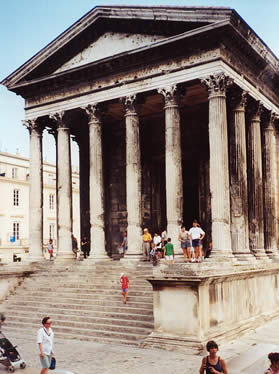
One of the most beautiful remnants of Roman civilisation in Gallia by example: "le Maison Carrée" or literally translated: "the square house". It's a temple (15 BC) dedicated to Agrippa and later to Gaius and Lucius Caesar. The temple is situated near the forum, which is nowadays a big paved square. The temple is in a tremendous state: the roof is still on; none of the pillars were ever replaced; the sculptures are still intact; the interior isn't badly damaged;... . Part of the conservation progress is that the temple has been a church and even a stable! But thanks to this use it has never been rebuild or changed. The temple is an example of a "Corinthian marble temple on a stage", you can compare it to a rectangle (126m on 15m) surrounded by Corinthian columns build on an artificial height of 2,5m (total height: 17m). This is one of the most delicate architecture I've ever seen. Today it's an exposition hall. I walked a bit further to the south in the city and encountered the Amphitheatre. It was build in approximately 50 AC just inside the city walls.
The Amphitheatre (131 on 100m) is well preserved, especially the lower floors. It is built following a (for that time) very complex building method: It consists out of 5 concentric tunnels, each on a different level with passages and stairs, which allowed the 23 000 spectators to enter and leave very quickly. The Amphitheatre is today still used for e.g. rock concerts, bullfighting, ... . Then they use a modern day vel(ari)um; which must be very useful because I can assure you it can be very, very hot inside that oval. When you climb up to the highest floors you have a great sight on the city of Nemausus. There must have been a circus too in Nemausus but there is nothing left of it.
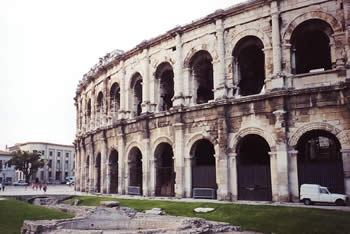 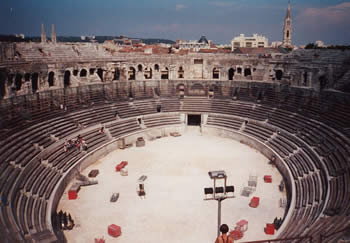
Also in the city of Nemausus is the "Castellum Divisorium"; a dividing place for the water that came from the hills outside the city, brought there by the wonderful Pont du Gard on which I will comment later. The water travelled more than 50km before it came in the Castellum Divisorium. All the fountains and public baths of Nemausus got their water from this point by a very complicated system of lead tubes.
The "Porte d'Auguste" or "Gateway of Augustus", is an authentic Roman gateway. It's divided into four arches, 2 small for the pedestrians on the side, and 2 bigger in the centre to let the heavier traffic pass. You still can see the marks of the carts in the stones. You can also notice the difference between the street level then and now. This wasn't a triumphal arch, it was just a gateway that allowed people to travel in and out the city and the soldiers to control everybody getting in and out.
In the "jardin de la fontaine" or "the water source garden" was a religious complex established. In this garden are (still) the holy water sources of Nemausus, and there still are some temples. The best preserved is the Diana Temple on the slope of a hill (from where you have a beautiful sight on Nîmes) with fantastic frescos. It is not open for the public, but I managed to get in by climbing over a 2,5m fence. It got me some scratches, but it was definitively worth while. With all these Roman remnants, you can imagine the richness of the collection of the Roman museum in Nemausus (musée des antiques). This is the place to be for some wonderful statues, mosaics, frescos, jewellery, ...
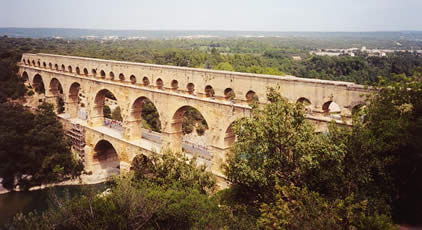
The Pont du Gard ( "Bridge over the Gard ") is an aqueduct that is part of the 50km long waterworks from the water sources near Uzés to the ancient city of Nemausus, and is in a perfect state. The fall between the sources and Nemausus was only 17m. This means the waterworks had only an average drop of 34cm per km! The waterworks had a capacity of 20 000m3 a day, so there was a lot of pressure on the pipes. That's why the drop on the straight lines is a bit stronger than in the curves.
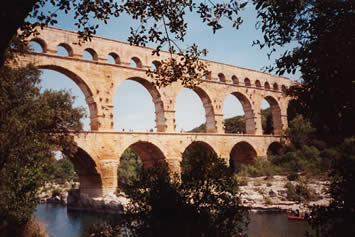
They started building the aqueduct 19 AC, and completed it under the government of the Emperor Claudius. The aqueduct exists of 3 levels of arches. The lowest level exists out of 5 big arches, the second level exists out of 10 arches, and the highest level exists out of 32 small arches. The aqueduct has a length (on the top) of 273m and a height of 49m. It is a little curved because it should resist the pressure of the river Gard, that flows beneath it, and can become a wild stream in winter. When you are standing in the valley it's unbelievable how such a large building can be so harmonious with its surroundings. The Romans really must have been genial architects.
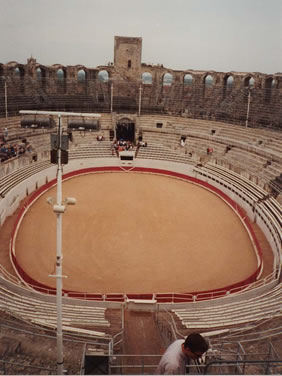
About 30 km more to the south is the city of Arles (Arelate). This city has been called "an open-air museum" by Chateaubriand. This city has 50 000 inhabitants (Nîmes: 134 000, Orange: 27 500). Together with Nîmes (Nemausus), Arelate has the best conserved Amphitheatre in France. Looking at the style, it was probably built by the same architect as the one who built the Amphitheatre at Nemausus (136m on 120m). It has been built between 50 and 75 AC. In the middle ages it has been a fortress, but in the 19th century it was restored in its original state, except for 3 towers (12th century). In this theatre has been found the famous statue "Venus of Arles" (Now to be seen in the Louvre Museum, Paris). Today it still can hold 12 000 spectators. I think the Amphitheatre in Nemausus is better conserved and offers a better view on Roman architecture. A bit further in the city lies the theatre. None of the scaena is left and the seats have been heavily restored, but it gives an idea about the importance of Arelate as a cultural centre.
Les Alicamps (The old Roman burial place) was used till the 13th century, but still offers a great deal of Roman sarcophaguses, some with pleasant texts on it, other with beautiful sculptures. Van Gogh painted this cemetery several times. The local museums have very rich collections of Roman tools, sarcophaguses, jewellery, ... .
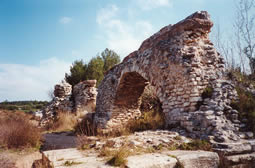
Not far away of the city of Arelate, in a little town called Barbégal, can the remnants of a double aqueduct be seen. This are really ruins, and just some pieces of the arches are left. Nonetheless it is a wonderful piece of architecture, especially on the place where it crosses a huge rock. The Romans just have drilled their way through it. What is more special about this aqueduct is the fact that this was an industrial building, made to drive the wheels of a giant corn mill in the valley.
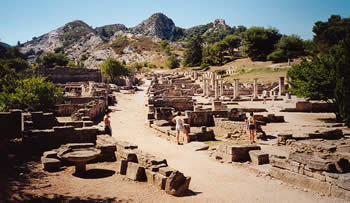
Saint Rémy de Provence is known for the famous painter Van Gogh. He lived and paited there for many years. But about a km from this little city, on the feet of "les Alpilles" ("the little Alps"), was an ancient Roman city called Glanum. On the right side of the road there is a giant mausoleum and a huge triumphal arch. The mausoleum is built between 30 and 20 BC. That was the time on which the Romans conquered Glanum. On the middle level of the Mausoleum there is an inscription that says: "SEX. L. M. IVLIEI. C. F. PARENTIBVS. SVIVS" translated : "Sextius, Lucius, Marcus, of the Jullii family, sons of Gaius, for their parents". Due to this inscription the archaeologists believed for a long time it was a Cenotaph, a monument for a dead person buried somewhere else, that remembered the grandchildren of the Emperor Augustus. Nowadays they think it's a mausoleum gifted by 3 brothers(Lucius, Marcus, Sextius) to their Father (Gaius) and their grandfather (parentibus), who were apparently Roman Cives. The pedestal is decorated with friezes representing hunting and war scenes. The first level is also square and exists out of arches and Corinthian pillars. On the highest level there are the statues from the father and the grandfather within a circle surrounded by small Corinthian pillars. The Mausoleum has a height of 18m.
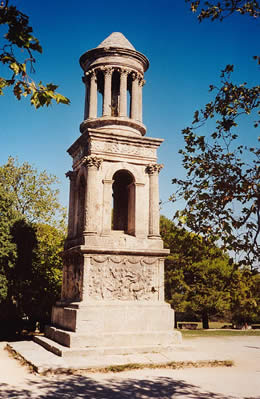
The triumphal arch (20 AC) must have been the entrance to the city of Glanum, on the other side of the (modern) road. The triumphal arch exists out of 1 big arch decorated with rich fruit and leaves patterns. The vault is decorated with a honey comb pattern. On the right and the left from the arch there are sculptures of groups of persons. Nobody knows what or who they represent. Walking through the arch you reach Glanum. Glanum is in origin a Celtic village, but after it was conquered and destroyed by Caesar the whole town was rebuild in the Roman way. In the middle of the city was a Holy source.
Around this source there was a great religious centre. There were many glorious and rich temples. They have been totally destroyed by the attacks of the Goths in 270 AC. There are also remnants of theatre. The most interesting in Glanum is the ancient Roman road and the homes (with shops) on both sides. On a certain moment the road becomes smaller and has some stairs in it. Then you really are in the heart of the city where so many people lived and worked. Strange how quiet it is there now.
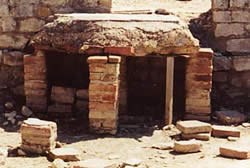
About 60 km to the North is the city of Vaison la Romaine ("the Roman Vasio") with its giant excavation sites. There are two of them. One is a residential site, the other is a religious-cultural centre. When you enter the site, you enter it on the Roman road that has been completely uncovered in its original state. This road is much wider than the one in Glanum. The road is paved and on the side, between the road and the footpath, there are remnants of Corinthian pillars. The houses on the side are no Insulae but huge residential houses, almost palaces, and have a shop (taberna) in front. When you enter the house by the front door (or where it was placed) you enter the atrium, still with the impluvium in the centre. You can go in the cubicula at the side or in the tablinum, almost always in front of the entrance. continue to the peristylium with lilies in the water. It most have been fantastic to live in a Domus! In some of them can still some mosaics be sighted or some beautiful statues. The domi continue till the road disappears under the modern road. There are also some fragments of the hypocaustum left. They can be sighted next to a Roman swimming pool. It was a part of the therms. The water in the pools were also heated by a system of hypocaustum. In a corner of the other excavation site public toilets (foricae) can be sighted and sat on! It is a strange feeling to sit where so many Romans ..., this must have been one of the most visited places in Vasio, and yet there is no human in sight, fortunately, because I like some privacy when I'm... . When you climb up the hill (after putting your trousers back on) you encounter a religious site. There must have been over 15 temples there. Now only some rocks are left, but when you climb over the hill, surprise, surprise, there is a fully intact theatre! Only the scaena doesn't exist anymore. The theatre is built on a natural slope and there are even some (Roman) tunnels through the slope to let the people enter and leave very easy. The collection of the nearby museum exists mainly out of tools, statues and mosaics, found (stolen) in the wealthy domi.
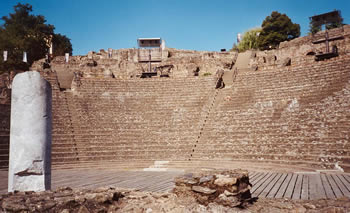
Lyon (Lugdunum), third city of France, is the birthplace of the Emperor Claudius. In 43 BC was Lugdunum founded by Lucius Munatius Plancus, by setting up a Roman colony in a Celtic village. The colony soon became the first and the biggest city in Gallia. On a 300m high hill still lies a Roman cultural complex: the oldest theatre of France (not exactly dated but rated about 1st century BC). The theatre is heavily restored, especially the seats. There are some decorations of the Scaena left. Next to the theatre lies an Odeon that was used for musical entertainment. There are not much remnants of the Odeon left. The Odeon and the theatre are built against a natural slope, on the top lies the remnant a temple. To this complex leads an ancient Roman road, in perfect state. When the road reaches the left side of the theatre, and thus the right side of the Odeon, it branches of into smaller roads. Lugdunum was also the place of the annual Conventum Galliarum; a convention on which the Celts could judge the Roman actions and approve or condemn them. This was done to unite the different Celtic tribes and to give them a feeling of participation.
Lugdunum has a very beautiful Roman museum. One of the masterpieces in the museum is the bronze "Claudian table", a speech of Claudius from 48 AC on a bronze plate. Thanks to this plate historians were able to verify Tacitus (Annales 11.24) who has written the same speech in his work. The words aren't exactly the same but the content is. So Tacitus seems to be a pretty reliable source.
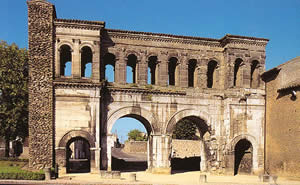
About 300 km more to the North, at the side of Burgundy, lies the city of Augustodunum (Autun), founded by Augustus just before the year 0. Augustodunum soon became a very wealthy city. It was known for its rhetorical school. There are some remnants of Roman culture left. The "porte Saint André", an gateway for entering the city, build between 0 and 20 AC. There is also a theatre (1st century AC) that has been heavily restored but is one of the biggest (in seize) I've ever seen. None of the scaena is left. A bit outside the city lies (the foundations of) the Janus Temple. Not much left of it yet!
| |